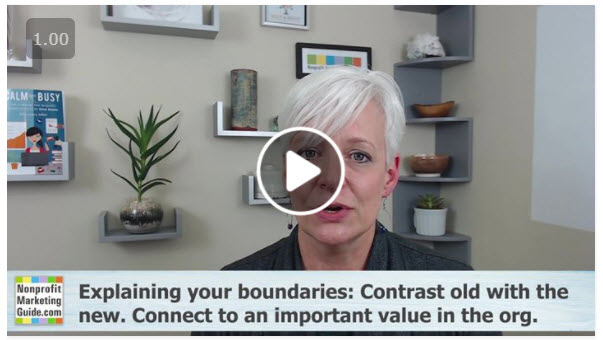On this afternoon’s #NPCOMM Chat Live on Facebook, I talked about how nonprofit communications staff need to set boundaries. You can check out the replay here.
Here’s a quick outline of what I discussed . . .
1. Define the Boundary
Before you can set boundaries, you need to know your own limits. When are you feeling overwhelmed, frustrated, uncomfortable, resentful, or guilty? These are all clues that your boundaries are being breached.
Most boundaries at work are about clarifying responsibilities and expectations. For communications staff, expectations around timing and frequency are also big sources of conflict. Think about turn-around times, how many drafts others comment on, etc.
2. Explain the Boundary
You have to contrast the current way things are done with the new way embodied in your boundary. Try something like this: I know you/we typically (insert behavior that you are trying to change/boundary crossed), but I strongly prefer that you/we (insert desired behavior/boundary enforced), so that (insert the desired result based on values of the organization).
The A in CALM is for Agile. You should build agility and flexibility into your work processes and decision-making. But then you draw boundaries around that built-in agility. Don’t let people take advantage of your built-in agility by expecting you to bend all the time, every time!
3. Enforce the Boundary
Every time your boundary is violated you need to say something and do something.
You can flip the earlier conversation around and say something like, “I know you aren’t used to (insert desired behavior/boundary enforced), but I need you to stop (insert behavior that you are trying to change/boundary crossed) so that (insert the desired result based on values of the organization). No matter how you phrase it, it’s essential that you bring it up as soon as possible.
Also, remember that boundary enforcement is as much about your behavior as it is about their behavior. They’ve crossed the boundary, so what’s your response? If you pretend like nothing has happened, you’ve erased your own boundary.
Sometimes, you might want to push them back over the line with a clear, firm “No.” Other times, you might want to walk them back over the line by negotiating how you can meet their needs while still meeting your own and maintaining the boundary.
But don’t just let it go! That means you are letting the boundary go too.
What boundaries have you successfully implemented? I’d love to hear what’s working for you in the comments.






